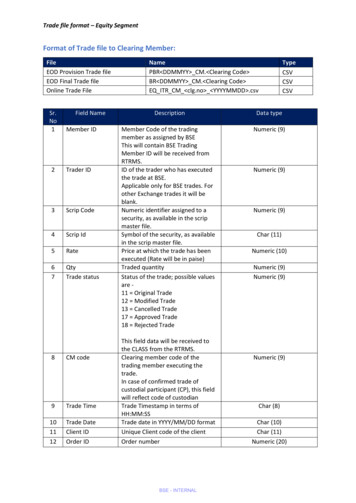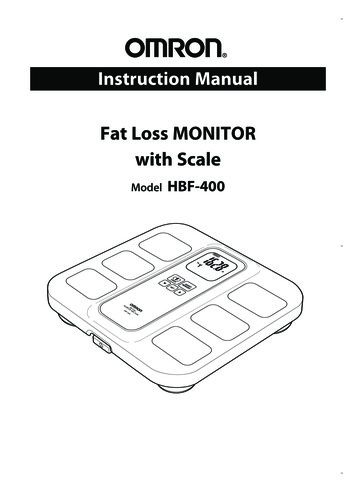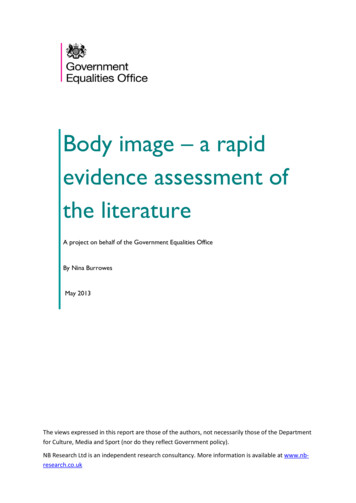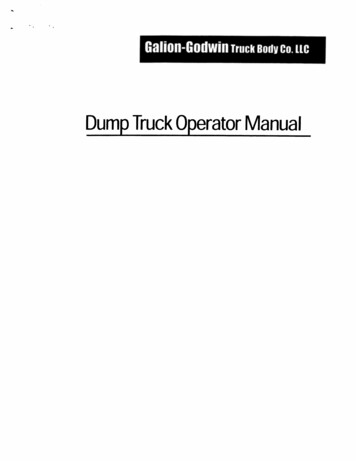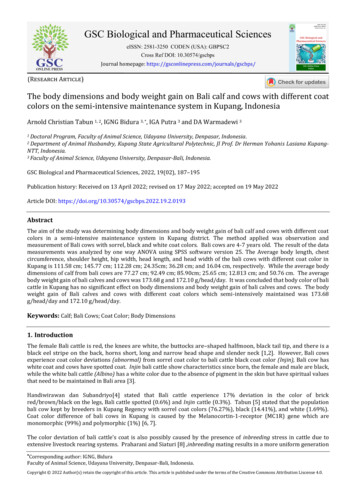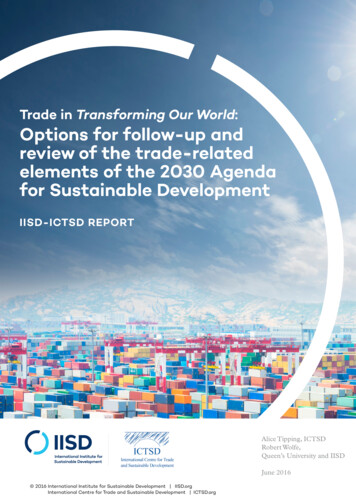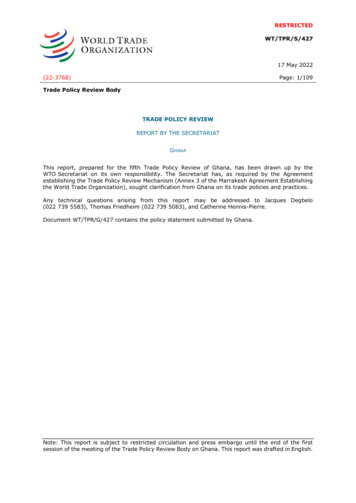
Transcription
RESTRICTEDWT/TPR/S/42717 May 2022(22-3768)Page: 1/109Trade Policy Review BodyTRADE POLICY REVIEWREPORT BY THE SECRETARIATGHANAThis report, prepared for the fifth Trade Policy Review of Ghana, has been drawn up by theWTO Secretariat on its own responsibility. The Secretariat has, as required by the Agreementestablishing the Trade Policy Review Mechanism (Annex 3 of the Marrakesh Agreement Establishingthe World Trade Organization), sought clarification from Ghana on its trade policies and practices.Any technical questions arising from this report may be addressed to Jacques Degbelo(022 739 5583), Thomas Friedheim (022 739 5083), and Catherine Hennis-Pierre.Document WT/TPR/G/427 contains the policy statement submitted by Ghana.Note: This report is subject to restricted circulation and press embargo until the end of the firstsession of the meeting of the Trade Policy Review Body on Ghana. This report was drafted in English.
WT/TPR/S/427 Ghana-2CONTENTSSUMMARY . 71ECONOMIC ENVIRONMENT . 101.1Main Features of the Economy .101.2Recent Economic Developments .121.3Developments in Trade and Foreign Direct Investment .161.3.1Merchandise trade .161.3.2Services trade .181.3.3Foreign investment .192TRADE AND INVESTMENT REGIMES. 202.1General Framework .202.2Trade Policy Objectives .212.3Trade Agreements and Arrangements .222.3.1World Trade Organization .222.3.2ECOWAS .232.3.3African Union .242.3.4Economic Partnership Agreement (EPA) with the European Union .252.3.5UK-Ghana EPA.252.3.6African Growth and Opportunity Act (AGOA) .252.4Foreign Investment Regime .262.4.1Overview .262.4.2Foreign investment restrictions .272.4.3Investment for infrastructure development .282.4.4Investment agreements.283TRADE POLICIES AND PRACTICES BY MEASURE . 293.1Measures Directly Affecting Imports .293.1.1Customs procedures and valuation .293.1.1.1Overview .293.1.1.2Single window .303.1.1.3Destination inspection scheme .313.1.1.4Customs valuation .313.1.2Tariffs .313.1.2.1Overview .313.1.2.2Applied MFN tariffs .333.1.2.3WTO bindings .363.1.2.4Duty concessions and exemptions .363.1.3Other taxes and charges affecting imports .383.1.3.1VAT .383.1.3.2Excise duties .383.1.3.3Other taxes and levies .39
WT/TPR/S/427 Ghana-33.1.4Preferential tariffs and rules of origin.403.1.4.1Rules of origin under ECOWAS and the African Continental Free Trade Area (AfCFTA) .413.1.4.2 Rules of origin under the agreements with the European Unionand the United Kingdom .433.1.5Import prohibitions, restrictions, and licensing .433.1.5.1Import prohibitions .433.1.5.2Import licensing .433.1.63.2Contingency measures .44Measures Directly Affecting Exports .453.2.1Export procedures .453.2.2Repatriation of export proceeds .453.2.3Rules of origin .453.2.4Export taxes and charges .463.2.5Export prohibitions, restrictions, and licensing .463.2.6Export incentives .463.2.6.1Export promotion .463.2.6.2Duty drawback .463.2.6.3Export subsidies .473.2.6.4Export finance, insurance, and guarantees .473.2.6.5Free zones .483.3Measures Affecting Production and Trade.503.3.1Incentives .503.3.2Local content requirements .503.3.3Standards and other technical requirements .503.3.4Sanitary and phytosanitary measures .533.3.5Competition policy .553.3.6State-owned enterprises, state trading, and privatization.553.3.7Government procurement .573.3.8Intellectual property rights .603.3.8.1Legal and institutional framework .603.3.8.2Main areas of intellectual property rights.613.3.8.3Enforcement.634TRADE POLICIES BY SECTOR . 644.1Main Features .644.1.1Agricultural policy .644.1.1.1Market access .664.1.1.2Domestic support .664.1.1.3Export subsidies .684.1.2Cocoa .684.1.3Forestry.714.1.4Fisheries .73
WT/TPR/S/427 Ghana-44.2Energy .754.2.1Oil .764.2.2Natural gas .794.2.3Electricity .804.3Mining .834.4Manufacturing .854.4.1Overview .854.4.2Pharmaceutical industry .874.4.3Automotive industry .904.5Services .914.5.1Overview .914.5.2Transport services .924.5.2.1Overview .924.5.2.2Rail transport services .934.5.2.3Maritime transport .944.5.2.4Air transport.964.5.3Telecommunications services .964.5.4Financial services .984.5.4.1Overview .984.5.4.2Banking services .994.5.4.3Insurance services . 1014.5.4.4Securities market . 1034.5.5Professional and other business services . 1044.5.6Tourism services. 1055APPENDIX TABLES . 106CHARTSChart 1.1 Prices of gold, cocoa beans, and crude oil, 2006-20 .12Chart 1.2 Product composition of merchandise trade by main HS section/subheading,2014 and 2019 .17Chart 1.3 Direction of merchandise trade, 2014 and 2019 .18Chart 1.4 Trade in services, 2014-20 .19Chart 1.5 FDI flows, 2007-20 .19Chart 3.1 Tax revenue by category, 2020 .32Chart 3.2 Distribution of MFN applied tariff rates, 2013 and 2022 .35Chart 3.3 Ghana's trade with ECOWAS members, 2014-19 .42Chart 3.4 ECOWAS Trade Liberalization Scheme – Approved products in 1988-2021 .42Chart 3.5 Exports under the Free Zones Scheme .49Chart 4.1 Production and trade of fish and fishery products, 2014-20 .74Chart 4.2 Ghana's trade in pharmaceuticals (HS 30), 2014-19.89
WT/TPR/S/427 Ghana-5Chart 4.3 Trade in services, 2006-20 .91Chart 4.4 Trade in transport services, 2014-20 .92Chart 4.5 Gross premiums collected by insurance services providers, 2010-20 . 101Chart 4.6 Market capitalization on the GSE, 2007-21 . 103TABLESTable 1.1 Selected macroeconomic indicators, 2014-20 .10Table 1.2 Balance of payments, 2014-20 .15Table 2.1 Selected trade-related laws and regulations adopted since 2014 .21Table 2.2 WTO notifications by Ghana, 2014-22 (31 March) .22Table 2.3 Regional macroeconomic convergence criteria .24Table 2.4 Minimum foreign investment requirements, 2022 .27Table 3.1 Notification status of TFA measures, March 2022 .29Table 3.2 Fiscal revenue, 2014-20 .33Table 3.3 Structure of MFN tariffs, 2013 and 2022 .34Table 3.4 Comparative analysis of Ghana's applied MFN tariff, 2007, 2013, and 2022 .35Table 3.5 Tariff exemption schemes, 2022 .37Table 3.6 Excise duties, 2022 .39Table 3.7 Taxes, levies, and charges applied to imported goods .39Table 3.8 Ghana's Export Procedures, 2022.45Table 3.9 Export permits .46Table 3.10 Selected tax incentives, 2022 .50Table 3.11 Imports subject to prior authorization or conformity assessment procedures .52Table 3.12 Selected SOEs, statutory corporations, and agencies, 2019 .56Table 3.13 Government procurement by type of procurement method, 2011-19 .57Table 3.14 Membership in IPR treaties, 2022 .60Table 3.15 Overview of IPR protection, 2022 .62Table 4.1 Production of the main agricultural crops, 2014-20 .65Table 4.2 Deliveries of subsidized fertilizers and seeds, 2016-20 .67Table 4.3 Market interventions by the National Food and Buffer Stock Company, 2019-20 .68Table 4.4 Production and exports of cocoa beans, 2014-21 .70Table 4.5 Timber production and trade, 2014-20 .71Table 4.6 Ghana's fishing fleet, 2014-20 .75Table 4.7 Royalty regime in the oil and gas sectors, 2022 .77Table 4.8 Distribution of oil export proceeds, 2018-21 .78Table 4.9 Natural gas production and imports, 2014-20 .79Table 4.10 Electricity generation capacity, 2014-20 .80Table 4.11 Electricity generation and trade, 2014-20 .81Table 4.12 Local participation requirements in the electricity sector.82Table 4.13 Mineral production, 2014-21 .83
WT/TPR/S/427 Ghana-6Table 4.14 Exports of minerals, 2014-21.83Table 4.15 Foreign investment in the mining sector, 2014-21 .83Table 4.16 10-Point Industrial Transformation Agenda .86Table 4.17 Selected telecom indicators, 2014-20 .97Table 4.18 Selected provisions of the Insurance Act, 2021 . 102Table 4.19 Selected regulated professions in Ghana, 2021 . 104Table 4.20 Tourism indicators, 2010-20 . 105BOXESBox 3.1 Procedures to import goods into Ghana .30Box 3.2 Computing VAT payable under the VFRS .38Box 3.3 Appeals and complaints cases, 2018-20 .59Box 4.1 Pharmaceutical products banned for production or import, 2021 .88Box 4.2 Developments in Ghana's ports .95APPENDIX TABLESTable A1.1 Merchandise exports by HS section and major chapter subheading, 2014-19 . 106Table A1.2 Merchandise imports by HS section and major chapter subheading, 2014-19. 107Table A1.3 Merchandise exports by destination, 2014-19 . 108Table A1.4 Merchandise imports by origin, 2014-19 . 109
WT/TPR/S/427 Ghana-7SUMMARY1.Ghana is a natural resource-based economy. Its strong democratic institutions and goodgovernance have contributed to attracting investment. The resultant economic growth has improvedthe per-capita income of its 31 million people to approximately USD 2,200 in 2020, againstUSD 2,000 at the time of the last Review in 2014. The World Bank ranks Ghana as a lowermiddle-income country.2.Ghana's trade-to-GDP ratio averaged 71% in 2018-20 and indicates that its economymoderately depends on international trade. The country is Africa's second-largest producer of gold,and is rich in diamonds, oil, and gas. Gold, crude oil, and cocoa beans (and cocoa paste and cocoabutter in limited quantities) together account for close to 85% of merchandise exports. Ghana's mainexport destinations are China, the European Union, Switzerland, India, and South Africa, while theEuropean Union and China remain its main import origins.3.Over the review period (2014-22), Ghana experienced three phases of modest to strongeconomic growth; it continues to face challenges to stabilize its economy. In fact, from 2014 to2016, Ghana witnessed a sharp economic slowdown with an average real GDP growth of 2.8% (downfrom an average of 6.6% in 2010-13), which was linked to a domestic banking and energy crisis.From 2017 to 2019, following a change in government, macroeconomic performance improved. RealGDP growth rebounded to an annual average of 6.9%, inflation was brought under control, and theGovernment's budget situation improved, thanks to greater fiscal discipline. In 2020, the economyheld up comparatively well with GDP growth of 0.4%, despite the worldwide COVID-19-relatedlockdowns, and closures of businesses and borders. To help mitigate the impact of the pandemic,the Government adopted the Coronavirus Alleviation Programme aimed at supporting vulnerablehouseholds and businesses. It also launched the Ghana CARES ("Obaatan pa") programme(GHS 100 billion, about USD 13 billion) focusing on agriculture, manufacturing, and the ICT/digitaleconomy. These mitigation efforts came at the expense of record fiscal deficit and public debt thatled the IMF to warn Ghana last year that it was at high risk of debt distress.4.Ghana's investment regime is fairly liberal and foreign investment is generally welcome.However, the State continues to have a significant stake in the economy with close to160 state-owned enterprises, agencies, and joint-ventures, many of which continue to make losses.Activities still reserved for Ghanaians range from small-scale mining to forex bureaux. Joint venturesby foreign enterprises with Ghanaian partners are subject to a minimum of 10% Ghanaian equityparticipation. Also, Ghana has introduced new restrictions on foreign investments in the energy andmining sectors through mandatory Ghanaian equity participation and local content.5.Ghana has submitted over 40 notifications to the WTO since the last Review and indicatedthat steps were being taken to fully meet the requirements in this area. Ghana participates in theEconomic Community of West African States (ECOWAS) and the African Continental Free Trade Area(AfCFTA), and consults with the other members of these groups on WTO issues. It signed bilateraltrade treaties with the European Union (EPA) in 2016 and the United Kingdom in 2021. As anECOWAS member, Ghana has implemented the Common External Tariff (CET) since 1 February 2016with national exceptions as per regional provisions. However, Ghana has been slow in domesticatingand implementing subsidiary ECOWAS legislation. Ghana has received tariff preferences from theEuropean Union and the United Kingdom since the adoption of its bilateral trade agreements witheach of these partners, and it started implementing its own tariff reductions in 2021.6.Ghana's bindings cover 15.1% of its tariff lines. Most agricultural tariffs are bound at a ceilingrate of 99% with some lower bound rates at 40% and 50%. About 1% of the non-agriculturaltariffs are bound. Ghana's 2022 applied MFN tariff (unchanged since 2019) is based on the CET andthe HS17 classification. The tariff consists of the five CET rates (zero, 5%, 10%, 20%, and 35%).As of March 2022, the average (unweighted) applied MFN tariff rate was 12.2%, down from 12.8%in 2013. The share of duty-free tariff lines was 1.6%, down from 12.2% in 2013, because most ofthe tariff lines that were duty-free in 2013 now carry a 5% rate under the CET. Some 45% of alltariff lines were subject to rates of 20% or 35% as of March 2022.7.Ghana's standard VAT rate has been 12.5% since 2017. Excise duties are imposed (on anad valorem basis) on imports and locally produced alcoholic and non-alcoholic beverages, andtobacco products. In addition, Ghana resorts to a host of other taxes and levies on imports, and
WT/TPR/S/427 Ghana-8their number has grown since the last Review. These taxes levied on most imports include theECOWAS Levy (1%), African Union Levy (0.2%), Environmental Tax (10%), Ghana Export-ImportBank Levy (0.75%), Ghana Education Fund Levy (2.5%), COVID-19 Health Recovery Levy (1%),National Health Insurance Levy (3.5% on imports and domestic goods/services), Sanitation andPollution Levy (specific), and Special Petroleum Tax (specific), as well as four Energy Sector Levies.Combined, all of these levies significantly increase the costs of imports into Ghana.8.On the other hand, Ghana offers exemptions and concessions, for various purposes, on importtariffs, other duties and charges, and internal taxes. In 2020, the reported "tax refunds" amountedto GHS 2.6 billion (approximately USD 460 million) or 5.8% of total tax revenues. Qualifying importsenter the country under letters granting exemptions from the Ministry of Finance, and initiated byother ministries and agencies, including the Ghana Investment Promotion Agency.9.Ghana has ratified the Agreement on Trade Facilitation and notified the dates for theimplementation of categories B and C commitments; 18 provisions are due for implementation in2022-23. It has simplified its import procedures by establishing a new single window at the border(Integrated Customs Management System (ICUMS)) and reducing the number of inspecting agenciesto three (Customs, Food and Drugs Authority, and Ghana Standards Authority). Destinationinspection by Customs is mandatory for all imports of USD 3,000 and above (unless a waiver isgranted). Inspection fees are ad valorem and do not thus reflect the cost of the service.10.Ghana maintains import prohibitions on unprocessed logs and certain pharmaceuticals, as wellas prohibitions based on, inter alia, health, safety, SPS and environmental grounds. There are alsoquantitative restrictions in place on imports of cement and poultry products. The TBT and SPSregimes remain largely unchanged. Ghana primarily adopts international standards; it has adopted29 ECOWAS standards. Ghana has submitted a number of notifications to the WTO TBT Committee,and one specific trade concern was raised regarding its automotive safety standards. Ghana has alsonotified the WTO SPS Committee of its new biosafety and meat inspection rules.11.Since the last Review, Ghana has for the first time adopted trade remedies legislation. It madeseveral notifications to the WTO, which were reviewed in 2020. The newly established GhanaInternational Trade Commission has recommended the implementation of an anti-dumping measureagainst aluminium coils and circles originating in, or imported from, China, and several anti-dumpinginvestigations are ongoing.12.Regarding measures affecting exports, Ghana maintains its requirements for foreign exchangerepatriation to banks registered in the country. The forex surrender requirements to the Bank ofGhana for cocoa and gold exports were eliminated. Export taxes are currently applied on timber,and certain hydrocarbons sold to airlines. Selected products are subject to special export permits.Two agencies, Ghana Export Promotion Agency and Ghana Export-Import Bank, are responsible forexport promotion and export financing. The WTO Committee on Agriculture has yet to receive anup-to-date export subsidy notification from Ghana. The country currently has four free zones, andinvestors may also obtain free-point status anywhere in the country. However, Ghana's exports fromfree zones have been declining. Accordingly, the free zone scheme would benefit from a cost-benefitreview for its possible reform.13.Ghana is neither a member nor
2.2 Trade Policy Objectives 2.9. International trade and foreign investment continued to feature prominently in Ghana's economic policy during the review period 2014-22, as embedded in the Ministry of Trade and Industry (MOTI)'s National Export Development Strategy for the Non-Traditional Export Sector 2020-2029, launched in 2020.
